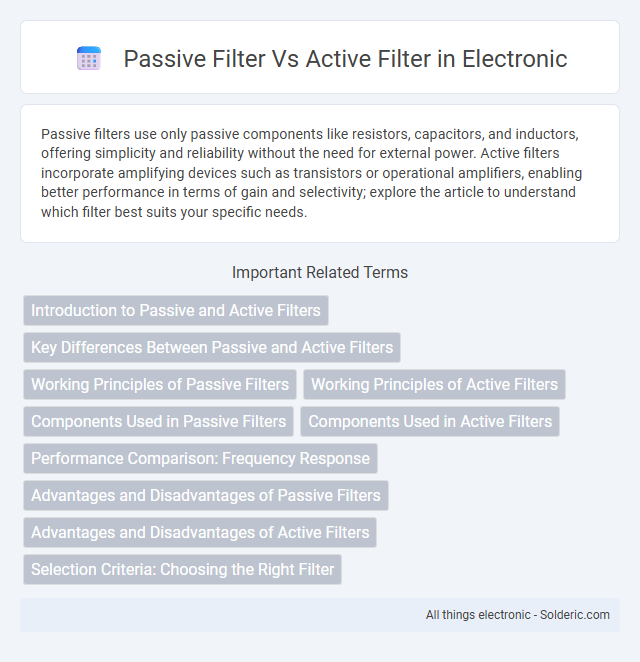Passive filters use only passive components like resistors, capacitors, and inductors, offering simplicity and reliability without the need for external power. Active filters incorporate amplifying devices such as transistors or operational amplifiers, enabling better performance in terms of gain and selectivity; explore the article to understand which filter best suits your specific needs.
Comparison Table
| Feature | Passive Filter | Active Filter |
|---|---|---|
| Components | Resistors, capacitors, inductors (no power source) | Op-amps, transistors, resistors, capacitors (requires power source) |
| Power Requirement | No external power needed | Requires external power supply |
| Signal Gain | No gain (attenuates signals) | Can provide gain and signal amplification |
| Frequency Range | Limited by inductor and capacitor quality | Wide frequency range, more flexible design |
| Impedance | Dependent on passive components | High input impedance, low output impedance |
| Size & Cost | Often smaller and cheaper but bulky inductors may be large | Generally compact, possibly higher cost due to active elements |
| Noise | Minimal noise added | May introduce additional noise from active components |
| Applications | Simple filtering, RF circuits, audio crossover networks | Audio processing, instrumentation, communication systems |
Introduction to Passive and Active Filters
Passive filters use only passive components like resistors, capacitors, and inductors to filter signals, offering simplicity and reliability without requiring external power. Active filters incorporate active elements such as operational amplifiers along with passive components, enabling amplification and more precise control of the frequency response. Your choice between passive and active filters depends on factors like signal gain needs, power availability, and desired filter performance.
Key Differences Between Passive and Active Filters
Passive filters use only passive components such as resistors, capacitors, and inductors, while active filters incorporate active components like operational amplifiers alongside passive elements. Active filters provide gain and better signal conditioning, enabling greater control over frequency response and impedance matching, unlike passive filters which can only attenuate signals. Passive filters are simpler, consume no power, and are more reliable at high frequencies, whereas active filters allow for complex designs and improved performance in low-frequency applications.
Working Principles of Passive Filters
Passive filters operate by using combinations of resistors, inductors, and capacitors to attenuate unwanted frequencies without the need for external power sources. These filters rely on the natural impedance characteristics of their components to block or pass specific frequency ranges, such as low-pass, high-pass, band-pass, or band-stop frequencies. Their simple design offers inherent stability and low noise, but they typically cannot provide amplification or signal gain like active filters.
Working Principles of Active Filters
Active filters use operational amplifiers, resistors, and capacitors to amplify and shape signals, allowing precise control over frequency response. Unlike passive filters, active filters can provide gain and do not rely solely on passive components, enabling better performance in low-frequency applications. Your circuit benefits from enhanced selectivity and stability due to the active components controlling signal manipulation directly.
Components Used in Passive Filters
Passive filters primarily use resistors, inductors, and capacitors as their core components, relying on these elements to control the frequency response without external power sources. Inductors and capacitors form the reactive elements that determine the filter's cutoff frequency and attenuation characteristics, while resistors help shape the overall impedance and damping. Your choice between passive and active filters depends on the specific application requirements, such as power consumption and signal gain.
Components Used in Active Filters
Active filters use components like operational amplifiers, resistors, and capacitors, enabling signal amplification and precise frequency control compared to passive filters that rely solely on resistors, inductors, and capacitors. The inclusion of active components in your filter design allows for improved performance with lower signal attenuation and adjustable gain. This makes active filters ideal for applications requiring high accuracy and flexibility in frequency response.
Performance Comparison: Frequency Response
Passive filters rely on resistors, capacitors, and inductors, offering a limited frequency response with attenuation primarily determined by component values and often suffering from signal loss. Active filters use operational amplifiers along with resistors and capacitors, providing improved frequency response with higher gain, sharper cutoffs, and better control over filter characteristics. Your choice between the two depends on the desired precision and signal handling requirements in applications needing specific frequency response performance.
Advantages and Disadvantages of Passive Filters
Passive filters offer advantages such as simplicity, reliability, no need for external power sources, and good performance at high frequencies. However, their disadvantages include limited gain, larger size for low-frequency applications, and less flexibility in tuning compared to active filters. You should consider these trade-offs when choosing a filter type based on your specific circuit requirements.
Advantages and Disadvantages of Active Filters
Active filters offer advantages such as amplification capabilities, allowing for signal boost without requiring inductors, which reduces size and weight. Their ability to achieve precise frequency response and higher input impedance makes them ideal for sensitive electronic circuits, though they require an external power source and can introduce noise or distortion. You benefit from greater design flexibility but must consider the trade-offs in power consumption and potential complexity compared to passive filters.
Selection Criteria: Choosing the Right Filter
Selection criteria for choosing between passive and active filters depend on factors such as frequency range, signal amplitude, power consumption, and cost efficiency. Passive filters are preferred for high-frequency applications and environments where low power and simplicity are critical, utilizing only resistors, capacitors, and inductors. Active filters offer greater versatility with amplification, precise tunability, and can operate effectively at low frequencies without inductors, making them suitable for complex, low-signal scenarios requiring improved filter performance.
passive filter vs active filter Infographic

 solderic.com
solderic.com